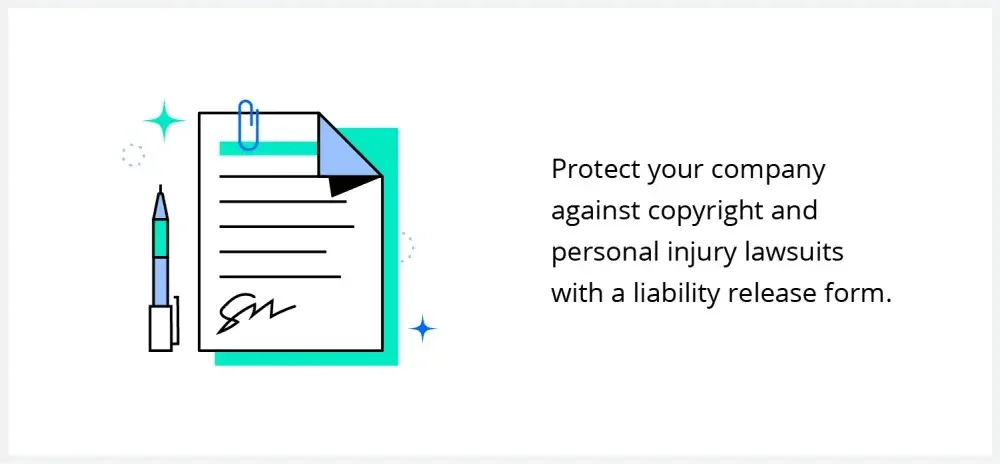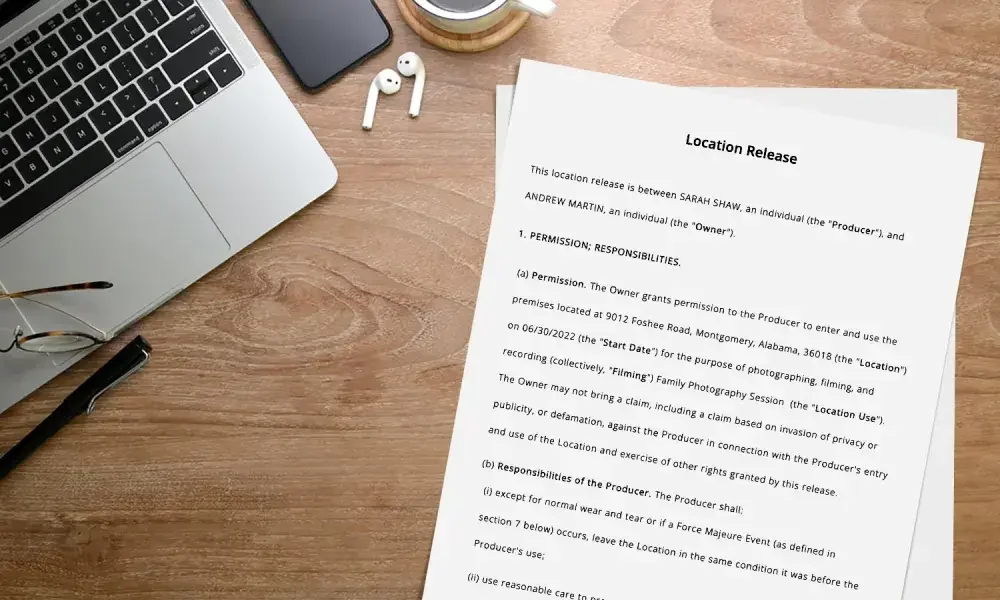Whether you're getting consent to use someone's photo, selling your services, or transferring ownership of a commercial asset that you created like a logo or promotional video, a release of liability form is designed to safeguard you against lawsuits by planning for and addressing potential disputes.
A release of liability, also known as a hold harmless agreement, is a legal agreement between two parties in which one party waives the right to hold the other responsible for potential damages.
For example, if you rent out your venue for corporate conferences, you may want to write a release form stating that you can't be held legally responsible for lost or stolen items. The release of liability contract serves as protection against financial and property damage lawsuits.
Takeaway: Release forms can be customized to help protect your company against liability issues.
What is the benefit of having a release form?
The primary reason freelancers and business owners use liability and intellectual property release forms is to reduce risk. Benefits include:
- Reducing the risk of lawsuits
- Lowering legal costs
- Protecting intellectual property rights
When to use a release form
Models and voice actors must release their likenesses to creative houses for production and marketing, photographers must release their images to journalists for publication, and graphic designers provide copyright releases when they sell designs to business owners.
Some other situations that may warrant the use of a release form include:
- Engaging in risky activities
- Collaborating on a creative project
- Building a new set or office
- Renting out property
Types of liability release forms
Most liability release forms are relatively similar. But specific information can vary depending on what you're using it for.
For example, if you own a gym, spa, hotel, or amusement park, lead outdoor tours, or host a concert, your release agreement will strongly emphasize the dangers associated with the activities you're offering to ensure customers are fully aware of the risks before they participate.
If you're renting out storage units or some other property, this documentation will focus on protecting you if the renter's property is stolen.
On the other hand, creative release forms give full commercial rights of any assets to the releasee. The most common types are model, talent, and location release forms.
Suppose you work in the arts and entertainment industry. In that case, you must learn the ins and outs of release agreements and liability waivers or introduce user-friendly online release forms into your legal compliance process.
Model release form
Any time you photograph someone, ask them to sign a model release form in case you decide to use the images you capture as commercial assets later on. This gives you full rights to use any photos you take for promotions, editorial use, and/or art exhibitions. When drafting a model release agreement, include the following:
- Permission to use the model's likeness
- Consent to digitally alter images
If you photograph a child younger than 18, you must also get their parent or guardian's signature.
Talent release form
This release form is similar to a model release form but more generalized. Use a talent release form whenever you want the right to use someone's visual and/or vocal likeness. You can create a talent release document for people, animals, or anything identifiable that appears in the media you capture. A talent release form should include:
- Talent type
- Consent for digital alterations
- Performance scope details
- Consent for commercial use
If your talent is a minor, you will need to get parental permission to use any footage you capture of them.
Location Release Form
Don't rely on a handshake with a property owner when you need access to a location for your photo or video shoot and the rights to show depictions of the property publicly. A location release of liability form should include:
- Location address
- Filming schedule and duration
- Location modifications
- Cleanup expectations
- Location depiction release
If the forms above don't suit your needs, you can use a submission release form, an audio recording release form, or an art release form.
Liability waiver wording and content: what needs to be included?
The wording of the liability waiver you attach to the release document will vary based on your industry. But you may want to include important liability waiver wording, such as a:
- Warning: Ask the reader to read the contract carefully before signing.
- Risk rundown: Be transparent about what risks the release should be aware of.
- Voluntary agreement: Everyone who signs the agreement must understand what they're doing and sign voluntarily.
- Release clause states that your company can't be held liable for property or asset misuse resulting in personal or financial injury.
- Indemnity agreement: Stipulate that if a customer wants to sue, they will be responsible for all court fees and legal costs.
- Description: Detail information about the project and expectations.
If applicable, you should also outline payment terms, NDAs, deadlines, and any other important information. After you disclose all relevant details, the releasor and releasee must sign the form.
Quick tips and things to avoid
The main purpose of creating a release agreement is to protect your business from lawsuits, but it also needs to clearly state what risks your customer can expect before they assume responsibility for any damages.
Don't hide important information
It's in your best interest to be transparent with your customers about the risks associated with your services.
- Tip: Avoid using complicated legal jargon to ensure that anyone who reads the release form understands what they're signing.
Do use electronic release form waivers
Simplify the liability release process with electronic waivers. Aside from the financial and environmental benefit of forgoing paper, this format ensures that you won't forget to include relevant information and that everyone who needs a copy can easily get one.
Don't leave blank spaces
Never leave blank spaces on a release form to pencil in key information later. This practice will inadvertently leave you open to additional liabilities. If you don't include everything at the time of signing, the release can later claim they didn't know what the contract entailed, making the whole contract void.
Liability release forms
Whether you're a photographer, videographer, producer, or business owner, you can benefit greatly from taking the time to write a liability release form whenever you embark on a new collaboration.
Even if you don't intend to publish something you've made or use commercially, you might change your mind at some point. When this happens, it's best to have all of your paperwork finished and filed, so nothing is holding you back from a great opportunity.
Get started with LegalZoom's general release of liability form today.




